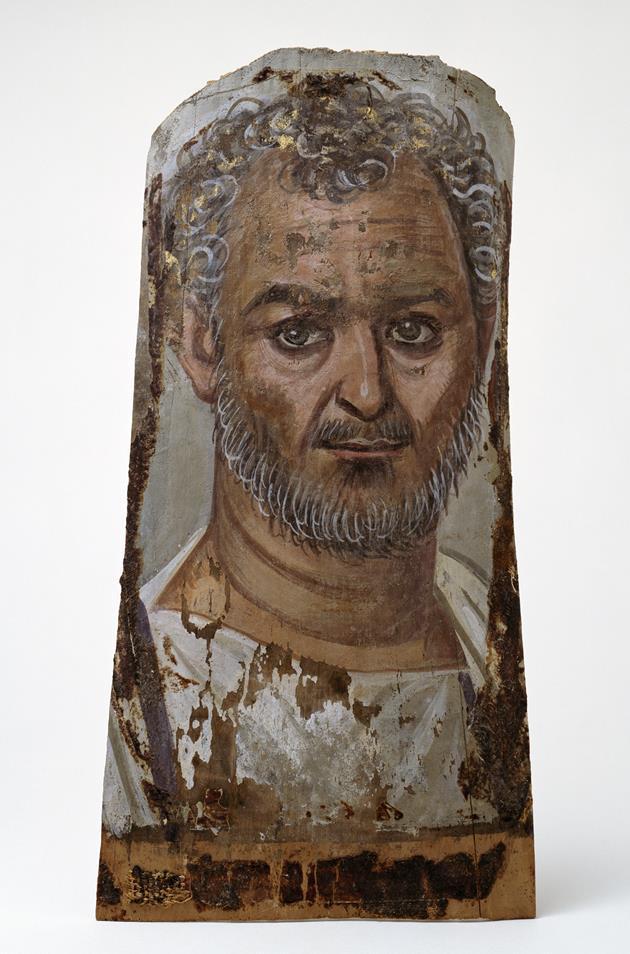Portraits of the Deceased in SAM's Collection
Funerary stele of Djefi and his wife, 2323-2150 B.C., Egyptian, El Kab, 45.11
Photo: Paul Macapia
Funerary stele of the house-mistress Udjarenes, 664-610 B.C., Egyptian, 48.224
Funerary Portrait, 1st-2nd century, Egyptian, 50.62
While based in part on more idealized Greek precedents, the "warts and all" authenticity of Roman portraits (from the Republican period onward) shows a modern audience the true faces of our Roman forebears.
Funerary Mask, late 1st century B.C., Egyptian, 71.55
Funerary Head, mid 19th century, African, Ghanaian, Akan, Adansi, 81.17.322
Photo: Paul Macapia
Sylvia Plath Quilt, 1980, Ross Palmer Beecher, 98.86
Visions of Death in SAM's Collection
Nirvana (Butsu Nehan-zu) , 17th-18th century, Japanese, 34.114
Der Ruf des Todes (The Call of Death), ca. 1934-35, Kathe Kollwitz, 39.73
Till Death, late 18th-early 19th century, Francisco José Goya y Lucientes, 44.493
Figure of Saint Francis Xavier, ca. 1738-40, German, Meissen manufactory, model by Johann Joachim Kändler, 54.135
Funerary bowl, 1000-1130 A.D., Mimbres, 76.12
Dance of Death, ca. 1400s, Michael Wolgemut and Wilhelm Pleydenwurff, 76.37
Death Shrine 2, ca. 1972-77, Kenneth Price, 88.15
Death with Woman in Lap, 1921, Kathe Kollwitz, 92.9
Who Would Be Buried in a Coffin Like This?
In southern Ghana, coffins are ordered from a workshop when a family member is nearing death. A proper coffin matches the coffin's image with the status or profession of the person it is made for. A Mercedes is ordered for a few people as a symbol of their success in business, especially for those with enough money to buy imported luxuries. Owners of large taxi fleets, wealthy market women and businessmen are likely to be buried in a Mercedes-like coffin for their journey to heaven. Funerals for people with this type of coffin are often accompanied by Christian services conducted outside the home of the deceased.
Armah Kofi's coffin, Teshi, Accra, Ghana, 2000
Photo: Matt Griggs
© GRIGGS MATT/CORBIS SYGMAWho Commissioned This Coffin?
This coffin was commissioned for museum display, not as a vehicle for burial. An American art dealer named Bill Wright traveled to Ghana to replace coffins that were damaged during a 1991 exhibition entitled Africa Explores. Carpenters usually construct coffins for clients who expect the coffin to be seen for only a short time and then be buried. Instead of serving the deceased in an African grave, the coffins Bill Wright commissioned are displayed as sculpture in museums. They suggest a different way to acknowledge the accomplishments of a person and mourn their death.
Carpenter apprentices working on coffins in Paa Joe's workshop in Teshi, Accra, Ghana, 2000
Photo: Matt Griggs
© GRIGGS MATT/CORBIS SYGMAWhen death strikes in Ghana, those who can afford to choose a coffin, organize feasts and hire orchestras whose music helps see off the deceased in style. Mourning turns to celebration as the coffin is carried to all the places that the deceased would want to say goodbye to. Praise salutes, blessings, prayers and hymns fill the air as the coffin is taken to a burial site. This manner of acknowledging death is one of many that involve art. In some communities, a figure memorializing or in honor of the deceased is buried or burned, concluding one phase of the grieving process. In other communities, a portrait keeps the person's image and memory alive forever. Certain artists depict death by capturing reactions to its news; others create imaginary visions of its presence.
Funeral procession, Ghana, 2005
© Madlyne PagtanacSelecting a Coffin to Fit
© Alida Latham
Paa Joe's coffin workshop, Ghana, 2005
© Alida Latham
Paa Joe's coffin workshop, Ghana, 2005
© Alida Latham
Paa Joe's coffin workshop, Ghana, 2005
© Alida Latham
Paa Joe's coffin workshop, Ghana, 2005
© Alida Latham
Paa Joe's coffin workshop, Ghana, 2005
© Alida Latham
Paa Joe's coffin workshop, Ghana, 2005
© Alida Latham
Paa Joe's coffin workshop, Ghana, 2005
© Alida Latham
Paa Joe's coffin workshop, Ghana, 2005
© Alida Latham
Paa Joe's coffin workshop, Ghana, 2005
© Alida Latham
Paa Joe's coffin workshop, Ghana, 2005
Six young people died in a shooting spree in Seattle one Saturday morning in March 2006. As a tribute to their memories, a twenty-five-foot-high pagoda was erected and displayed at Seattle Center in August of that year. Hundreds of viewers added personal notes, photographs and art to the pagoda to acknowledge the deaths. On Sunday morning, September 3, 2006, the pagoda was lit and quickly burned at the annual Burning Man gathering in Nevada.
There are numerous examples of art that disappears from sight to commemorate the loss of life. Funeral ceremonies in many parts of the world involve an action that heightens all the senses of the mourners. Whether buried or burned, art can frame the memories of a person for the living to hold.
The Temple of Light, Seattle Center, 2006
Photo: Mark Donovan, licensed under Creative Commons



























